Preparation and Photocathodic Protection Properties of ZnO/TiO2 Heterojunction Film Under Simulated Solar Light
Abstract
:1. Introduction
2. Experimental
2.1. Preparation of TiO2 Nanorod Arrays
2.2. Preparation of ZnO/TiO2 Heterojunction Double Layer Film
2.3. Characterization
2.4. Electrode Fabrication and Photoelectrochemical Measurements
3. Results and Discussion
3.1. Morphology and Crystal Structure Analysis
3.2. Light Absorption and Charge Mobility
3.3. Photocathodic Protection Performances
3.4. Possible Photocathodic Protection Mechanism
4. Conclusions
Author Contributions
Funding
Conflicts of Interest
References
- Imokawa, T.; Fujisawa, R.; Suda, A.; Tsujikawa, S. Protection of 304 Stainless steel with TiO2 coating. Zairyo-to-Kankyo 1994, 43, 482–486. [Google Scholar] [CrossRef]
- Guan, Z.C.; Wang, X.; Jin, P.; Tang, Y.Y.; Wang, H.P.; Song, G.L.; Du, R.G. Enhanced photoelectrochemical performances of ZnS-Bi2S3/TiO2/WO3 composite film for photocathodic protection. Corros. Sci. 2018, 143, 31–38. [Google Scholar] [CrossRef]
- Zhu, Y.F.; Xu, L.; Hu, J.; Zhang, J.; Du, R.G.; Lin, C.J. Fabrication of heterostructured SrTiO3/TiO2 nanotube array films and their use in photocathodic protection of stainless steel. Electrochim. Acta 2014, 121, 361–368. [Google Scholar] [CrossRef]
- Li, H.; Wang, X.T.; Zhang, L.; Hou, B.R. Preparation and photocathodic protection performance of CdSe/reduced graphene oxide/TiO2 composite. Corros. Sci. 2015, 94, 342–349. [Google Scholar] [CrossRef]
- Hu, J.; Liu, Q.; Zhang, H.; Chen, C.D.; Liang, Y.; Du, R.G.; Lin, C.J. Facile ultrasonic deposition of SnO2 nanoparticles on TiO2 nanotube films for enhanced photoelectrochemical performances. J. Mater. Chem. A 2015, 3, 22605–22613. [Google Scholar] [CrossRef]
- Cui, S.W.; Yin, X.Y.; Yu, Q.L.; Liu, Y.P.; Wang, D.A.; Zhou, F. Polypyrrole nanowire/TiO2 nanotube nanocomposites as photoanodes for photocathodic protection of Ti substrate and 304 stainless steel under visible light. Corros. Sci. 2015, 98, 471–477. [Google Scholar] [CrossRef]
- Lei, J.; Shao, Q.; Wang, X.T.; Wei, Q.Y.; Yang, L.H.; Li, H.; Huang, Y.L.; Hou, B.R. ZnFe2O4/TiO2 nanocomposite films for photocathodic protection of 304 stainless steel under visible light. Mater. Res. Bull. 2017, 95, 253–260. [Google Scholar] [CrossRef]
- Cui, J.; Pei, Y.S. Enhanced photocathodic protection performance of Fe2O3/TiO2 heterojunction for carbon steel under simulated solar light. J. Alloy. Compd. 2019, 779, 183–192. [Google Scholar] [CrossRef]
- Li, H.; Li, Y.H.; Wang, M.; Niu, Z.; Wang, X.T.; Hou, B.R. Preparation and photocathodic protection property of ZnIn2S4/RGO/TiO2 composites for Q235 carbon steel under visible light. Nanotechnology 2018, 29, 435706. [Google Scholar] [CrossRef]
- Subasri, R.; Deshpande, S.; Seal, S.; Shinohara, T. Evaluation of the Performance of TiO2–CeO2 Bilayer Coatings as Photoanodes for Corrosion Protection of Copper. Electrochem. Solid-State Lett. 2006, 9, B1–B4. [Google Scholar] [CrossRef]
- Sun, W.X.; Cui, S.W.; Wei, N.; Chen, S.G.; Liu, Y.P.; Wang, D.A. Hierarchical WO3/TiO2 nanotube nanocomposites for efficient photocathodic protection of 304 stainless steel under visible light. J. Alloy. Compd. 2018, 749, 741–749. [Google Scholar] [CrossRef]
- Zhang, J.J.; Rahman, Z.; Zheng, Y.B.; Zhu, C.; Tian, M.K.; Wang, D.A. Nanoflower like SnO2-TiO2 nanotubes composite photoelectrode for efficient photocathodic protection of 304 stainless steel. Appl. Surf. Sci. 2018, 457, 516–521. [Google Scholar] [CrossRef]
- Zhou, M.J.; Zhang, N.; Zhang, L.; Yan, J.H. Photocathodic protection properties of TiO2–V2O5 composite coatings. Mater. Corros. 2013, 64, 996–1000. [Google Scholar] [CrossRef]
- Liu, Q.; Hu, J.; Liang, Y.; Guan, Z.C.; Zhang, H.; Wang, H.P.; Du, R.G. Preparation of MoO3/TiO2 Composite Films and Their Application in Photoelectrochemical Anticorrosion. J. Electrochem. Soc. 2016, 163, C539–C544. [Google Scholar] [CrossRef]
- Han, C.; Shao, Q.; Lei, J.; Zhu, Y.F.; Ge, S.S. Preparation of NiO/TiO2 p-n heterojunction composites and its photocathodic protection properties for 304 stainless steel under simulated solar light. J. Alloy. Compd. 2017, 703, 530–537. [Google Scholar] [CrossRef]
- Guan, Z.C.; Wang, H.P.; Wang, X.; Hu, J.; Du, R.G. Preparation of NiO/TiO2 p-n heterojunction composites and its photocathodic protection properties for 304 stainless steel under simulated solar light. Corros. Sci. 2018, 136, 60–69. [Google Scholar] [CrossRef]
- Shao, J.; Zhang, Z.D.; Wang, X.T.; Zhao, X.D.; Ning, X.B.; Lei, J.; Li, X.R.; Hou, B.R. Synthesis and Photocathodic Protection Properties of Nanostructured SnS/TiO2 Composites. J. Electrochem. Soc. 2018, 165, H601–H606. [Google Scholar] [CrossRef]
- Boonserm, A.; Kruehong, C.; Seithtanabutara, V.; Artnaseaw, A.; Kwakhong, P. Photoelectrochemical response and corrosion behavior of CdS/TiO2 nanocomposite films in an aerated 0.5 M NaCl solution. Appl. Surf. Sci. 2017, 419, 933–941. [Google Scholar] [CrossRef]
- Ning, X.B.; Ge, S.S.; Wang, X.T.; Li, H.; Li, X.R.; Liu, X.Q.; Huang, Y.L. Preparation and photocathodic protection property of Ag2S-TiO2 composites. J. Alloy. Compd. 2017, 719, 15–21. [Google Scholar] [CrossRef]
- Ge, S.S.; Zhang, Q.X.; Wang, X.T.; Li, H.; Zhang, L.; Wei, Q.Y. Photocathodic protection of 304 stainless steel by MnS/TiO2 nanotube films under simulated solar light. Surf. Coat. Technol. 2015, 283, 172–176. [Google Scholar] [CrossRef]
- Wang, W.C.; Wang, X.T.; Wang, N.; Ning, X.B.; Li, H.; Lu, D.Z.; Liu, X.J.; Zhang, Q.C.; Huang, Y.L. Bi2Se3 Sensitized TiO2 Nanotube Films for Photogenerated Cathodic Protection of 304 Stainless Steel Under Visible Light. Nanoscale. Res. Lett. 2018, 13, 295. [Google Scholar] [CrossRef]
- Wang, X.T.; Wei, Q.Y.; Li, J.R.; Li, H.; Zhang, Q.X.; Ge, S.S. Preparation of NiSe2/TiO2 nanocomposite for photocathodic protection of stainless steel. Mater. Lett. 2016, 185, 443–446. [Google Scholar] [CrossRef]
- Wei, Q.Y.; Wang, X.T.; Ning, X.B.; Li, X.R.; Shao, J.; Li, H.; Wang, W.C.; Huang, Y.L.; Hou, B.R. Characteristics and anticorrosion performance of WSe2/TiO2 nanocomposite materials for 304 stainless steel. Surf. Coat. Technol. 2018, 352, 26–32. [Google Scholar] [CrossRef]
- Wen, Z.H.; Wang, N.; Wang, J.; Hou, B.R. Ag and CoFe2O4 co-sensitized TiO2 nanowire for photocathodic protection of 304 SS under visible light. Int. J. Electrochem. Sci. 2018, 13, 752–761. [Google Scholar] [CrossRef]
- Wang, X.T.; Lei, J.; Shao, Q.; Li, X.R.; Ning, X.B.; Shao, J.; Duan, J.Z.; Hou, B.R. Preparation of ZnWO4/TiO2 composite film and its photocathodic protection for 304 stainless steel under visible light. Nanotechnology 2019, 30, 045710. [Google Scholar] [CrossRef]
- Shen, H.Y.; Zhou, X.X.; Dong, W.; Su, X.D.; Fang, L.; Wu, X.; Shen, M.R. Dual role of TiO2 buffer layer in Pt catalyzed BiFeO3 photocathodes: Efficiency enhancement and surface protection. Appl. Phys. Lett. 2017, 111, 123901. [Google Scholar] [CrossRef]
- Wojtyła, S.; Baran, T. Copper zinc oxide heterostructure nanoflowers for hydrogen evolution. Int. J. Hydrog. Energy 2019, 44, 27343–27353. [Google Scholar] [CrossRef]
- Baran, T.; Visibile, A.; Wojtył, S.; Marelli, M.; Checchia, S.; Scavini, M.; Malara, F.; Naldoni, A.; Vertova, A.; Rondinini, S.; et al. Reverse type I core—CuI /shell—CuO: A versatile heterostructure for photoelectrochemical applications. Electrochim. Acta 2018, 266, 441–451. [Google Scholar] [CrossRef]
- Wedege, K.; Bae, D.; Dražević, E.; Mendes, A.; Vesborg, P.C.; Bentien, A. Unbiased, complete solar charging of a neutral flow battery by a single Si photocathode. RSC Adv. 2018, 8, 6331–6340. [Google Scholar] [CrossRef]
- Bae, D.; Seger, B.; Hansen, O.; Vesborg, P.; Chorkendorff, I. Durability Testing of Photoelectrochemical Hydrogen Production under Day/Night Light Cycled Conditions. ChemElectroChem 2019, 6, 106–109. [Google Scholar] [CrossRef]
- Azevedo, J.; Tilley, S.; Schreier, M.; Sousa, M.; Araújo, C.; Mendes, A.; Grätzel, M.; Mayer, M. Tin oxide as stable protective layer for composite cuprous oxide water-splitting photocathodes. Nano Energy 2016, 24, 10–16. [Google Scholar] [CrossRef] [Green Version]
- Hendry, E.; Koeberg, M.; ORegan, B.; Bonn, M. Local Field Effects on Electron Transport in Nanostructured TiO2 Revealed by Terahertz Spectroscopy. Nano Lett. 2006, 6, 755–759. [Google Scholar] [CrossRef]
- Chen, H.; Chen, C.; Chang, Y.; Tsai, C.W.; Liu, R.; Hu, S.; Chang, W.; Chen, K. Quantum dot monolayer sensitized ZnO nanowire array photoelectrodes: True efficiency for water splitting. Angew. Chem. 2010, 122, 6102–6105. [Google Scholar] [CrossRef]
- Cao, C.L.; Hua, C.G.; Wang, X.; Wang, S.X.; Tian, Y.S.; Zhang, H.L. UV sensor based on TiO2 nanorod arrays on FTO thin film. Sens. Actuators B Chem. 2011, 156, 114–119. [Google Scholar] [CrossRef]
- Pandiyan, R.; Micheli, V.; Ristic, D.; Bartali, R.; Pepponi, G.; Barozzi, M.; Gottardi, G.; Ferrari, M.; Laidani, N. Structural and near-infra red luminescence properties of Nd-doped TiO2 films deposited by RF sputtering. J. Mater. Chem. 2012, 22, 22424–22432. [Google Scholar] [CrossRef]
- Wu, J.J.; Liu, S.C. Low-temperature growth of well-aligned ZnO nanorods by chemical vapor deposition. Adv. Mater. 2002, 14, 215–218. [Google Scholar] [CrossRef]
- Hu, J.; Guan, Z.C.; Liang, Y.; Zhou, J.Z.; Liu, Q.; Wang, H.P.; Zhang, H.; Du, R.G. Bi2S3 modified single crystalline rutile TiO2 nanorod array films for photoelectrochemical cathodic protection. Corros. Sci. 2017, 125, 59–67. [Google Scholar] [CrossRef]
- Li, F.B.; Li, X.Z. Photocatalytic properties of gold/gold ion-modified titanium dioxide for wastewater treatment. Appl. Catal. A 2002, 228, 15–27. [Google Scholar] [CrossRef]
- Kern, R.; Sastrawan, R.; Ferber, J.; Stangl, R. Modeling and interpretation of electrical impedance spectra of dye solar cells operated under open-circuit conditions. Electrochim. Acta 2002, 47, 4213–4225. [Google Scholar] [CrossRef]
- Sun, S.M.; Wang, W.Z.; Zhang, L. Bi2WO6 quantum dots decorated reduced graphene oxide: Improved charge separation and enhanced photoconversion efficiency. J. Phys. Chem. C 2013, 117, 9113–9120. [Google Scholar] [CrossRef]
- Zhou, M.J.; Zeng, Z.O.; Zhong, L. Photogenerated cathode protection properties of nano-sized TiO2/WO3 coating. Corros. Sci. 2009, 51, 1386–1391. [Google Scholar] [CrossRef]
- Zhou, M.J.; Hou, Z.H.; Chen, X.B. Graphitic-C3N4 nanosheets: Synergistic effects of hydrogenation and n/n junctions for enhanced photocatalytic activities. Dalton Trans. 2017, 46, 10641–10649. [Google Scholar] [CrossRef]
- Sabaté, J.; March, S.; Simarro, R.; Giménez, J. Photocatalytic production of hydrogen from sulfide and sulfite waste streams: A kinetic model for reactions occurring in illuminating suspensions of CdS. Chem. Eng. Sci. 1990, 45, 3089–3096. [Google Scholar] [CrossRef]
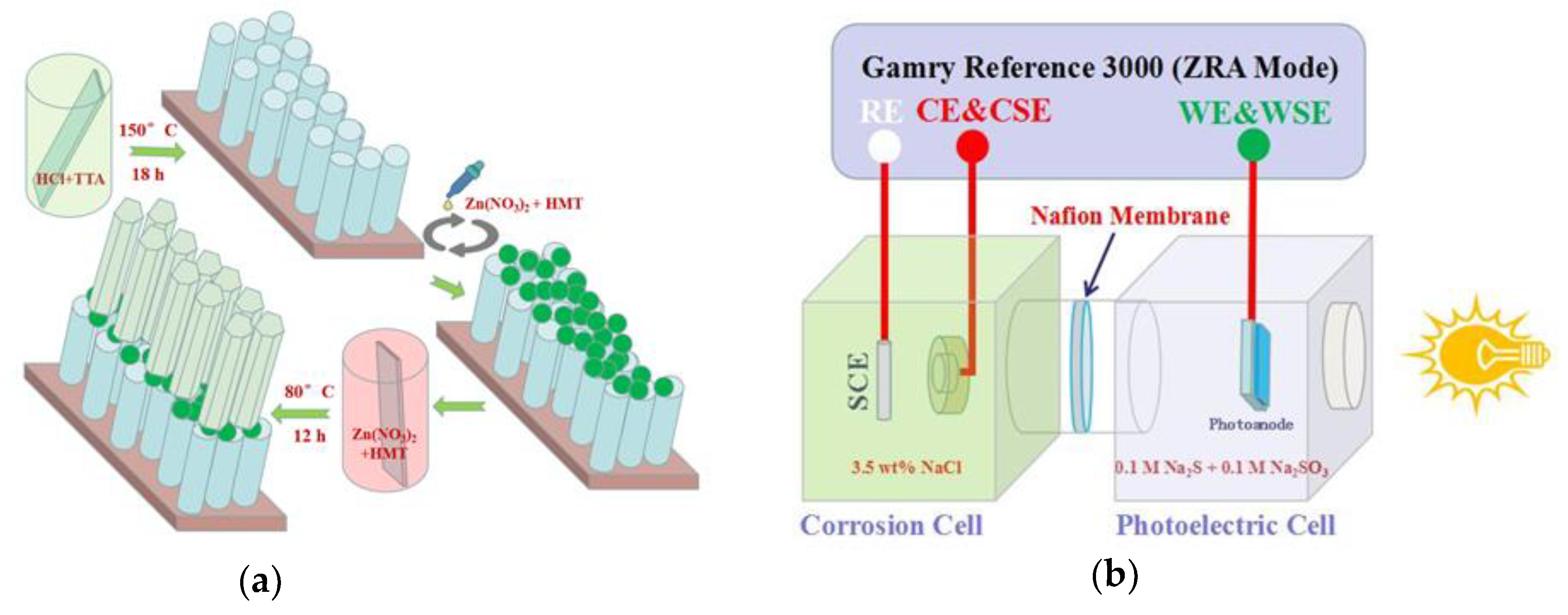
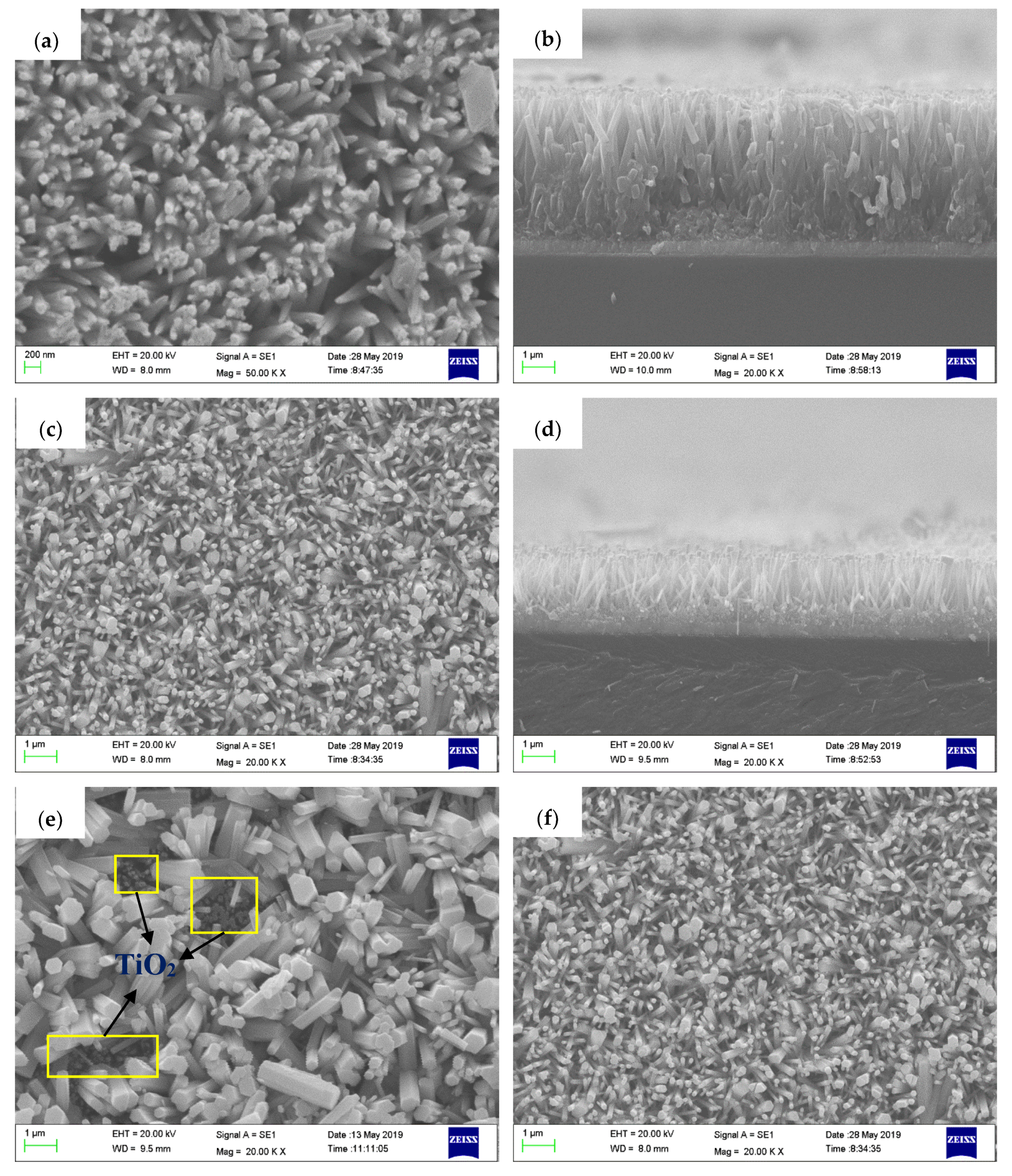
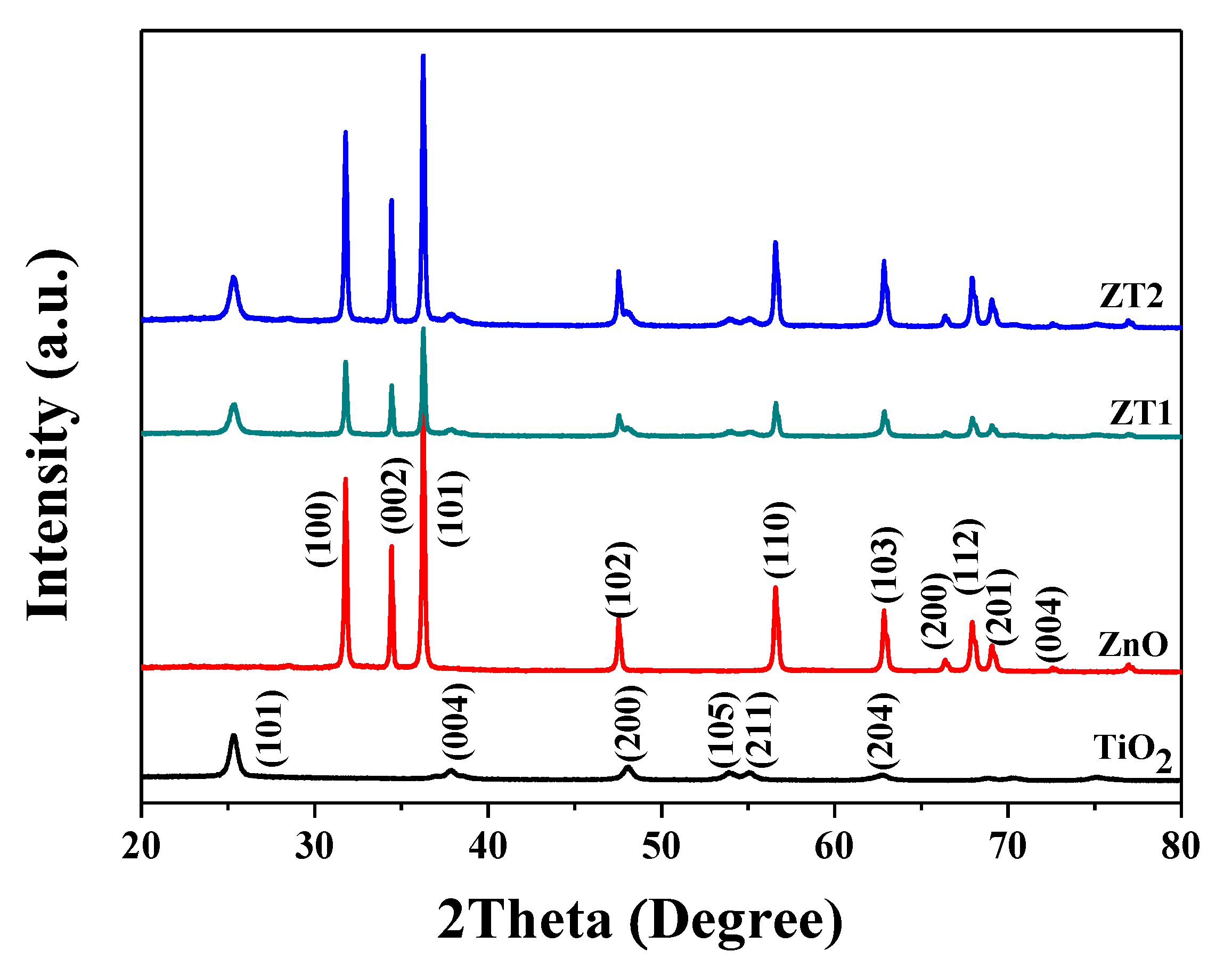
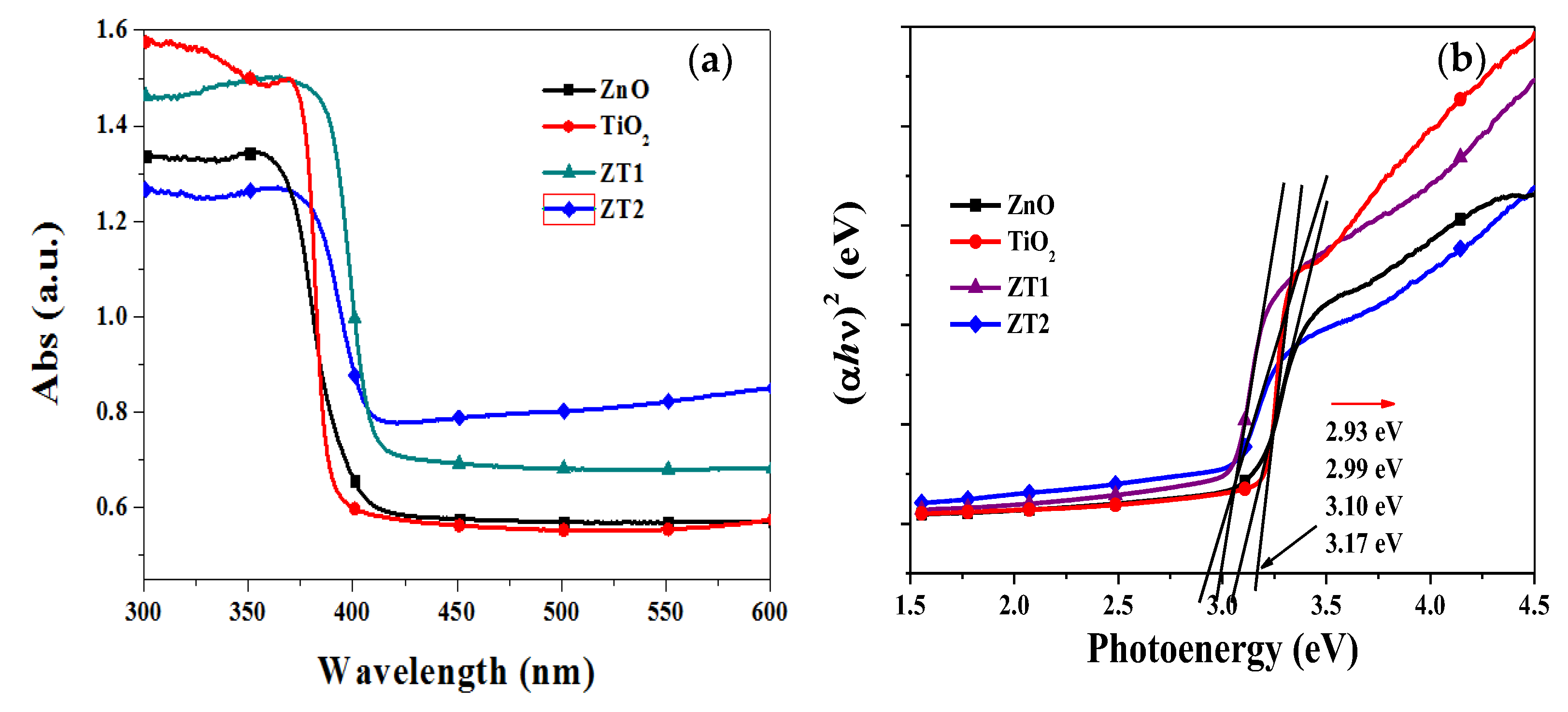

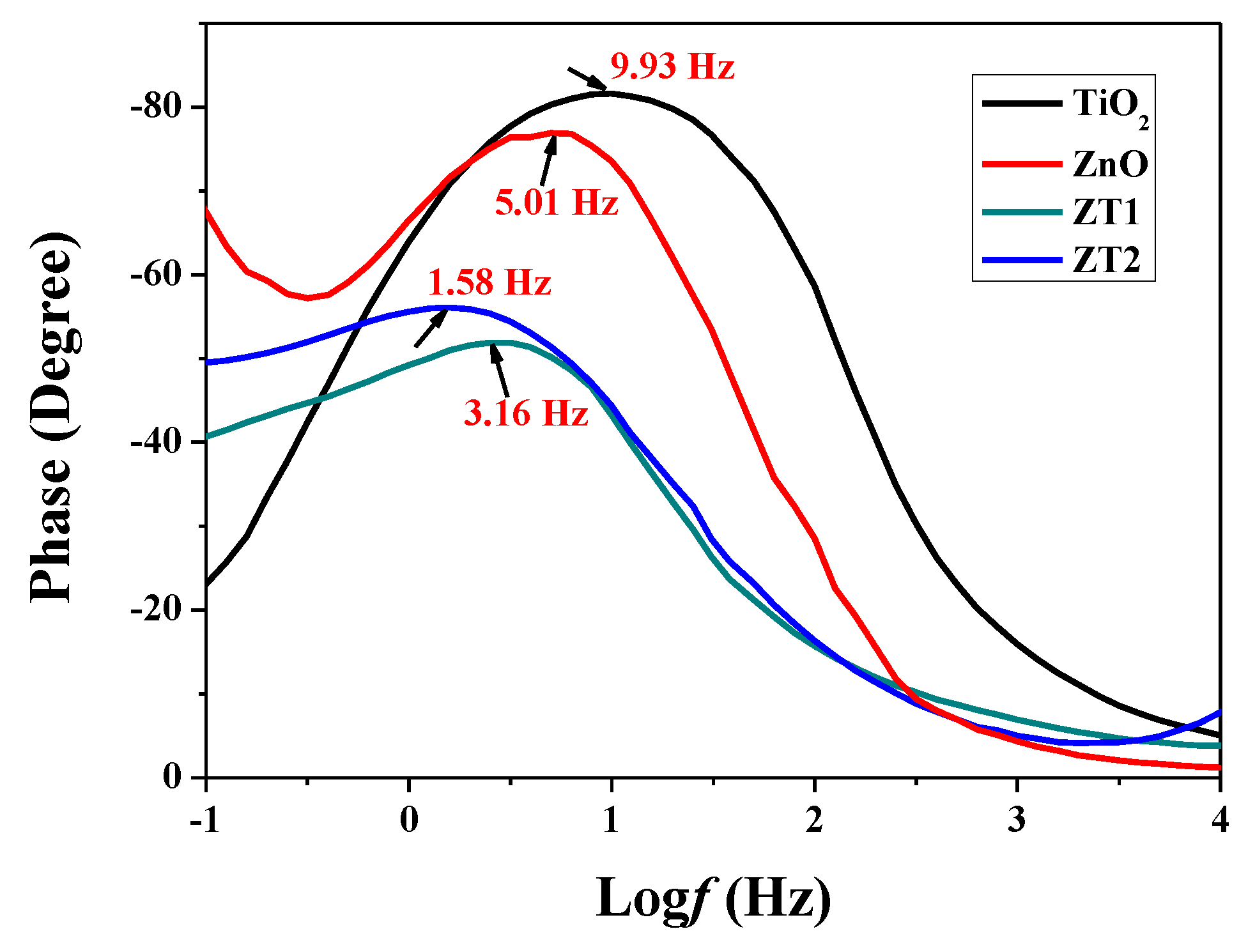

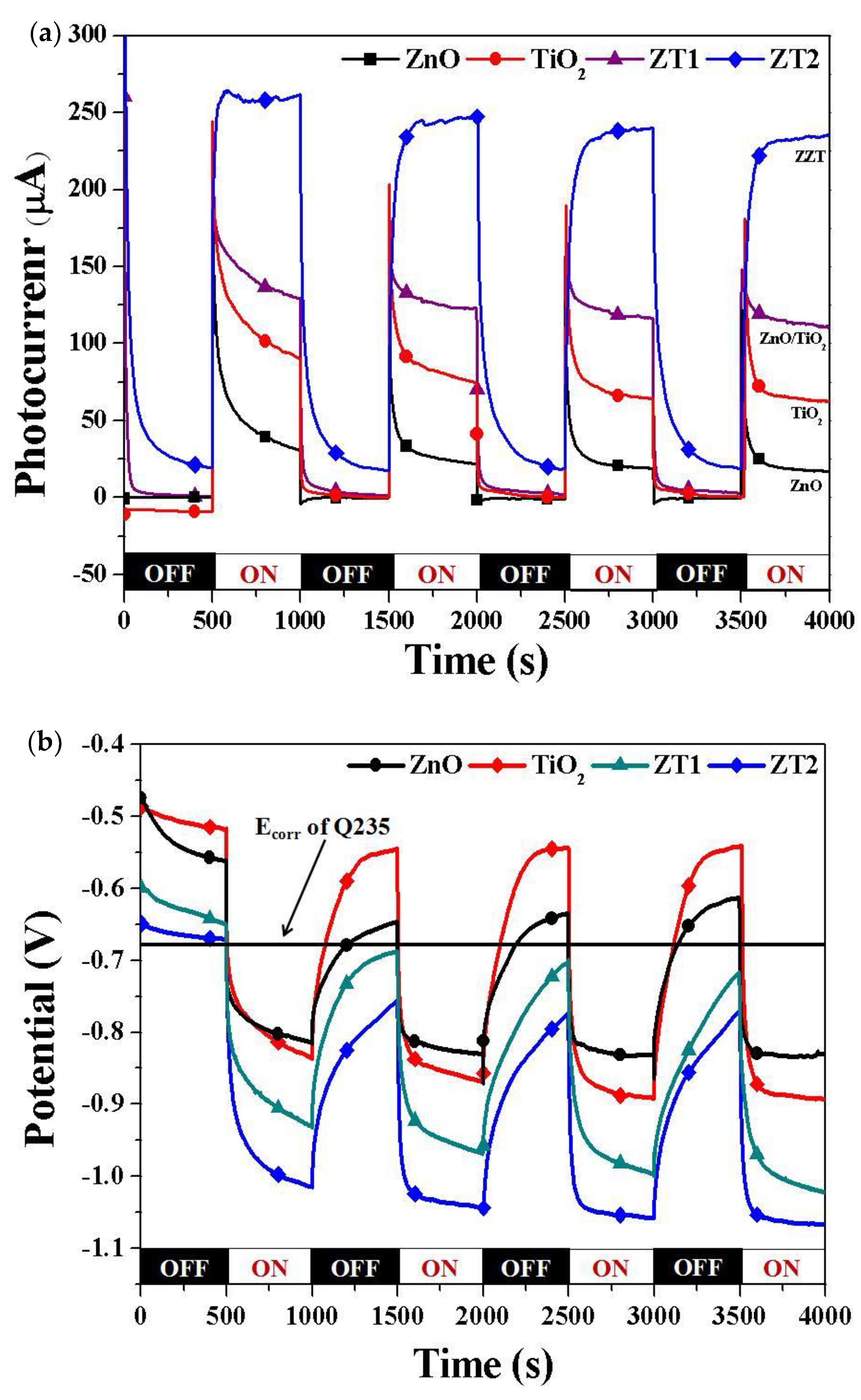
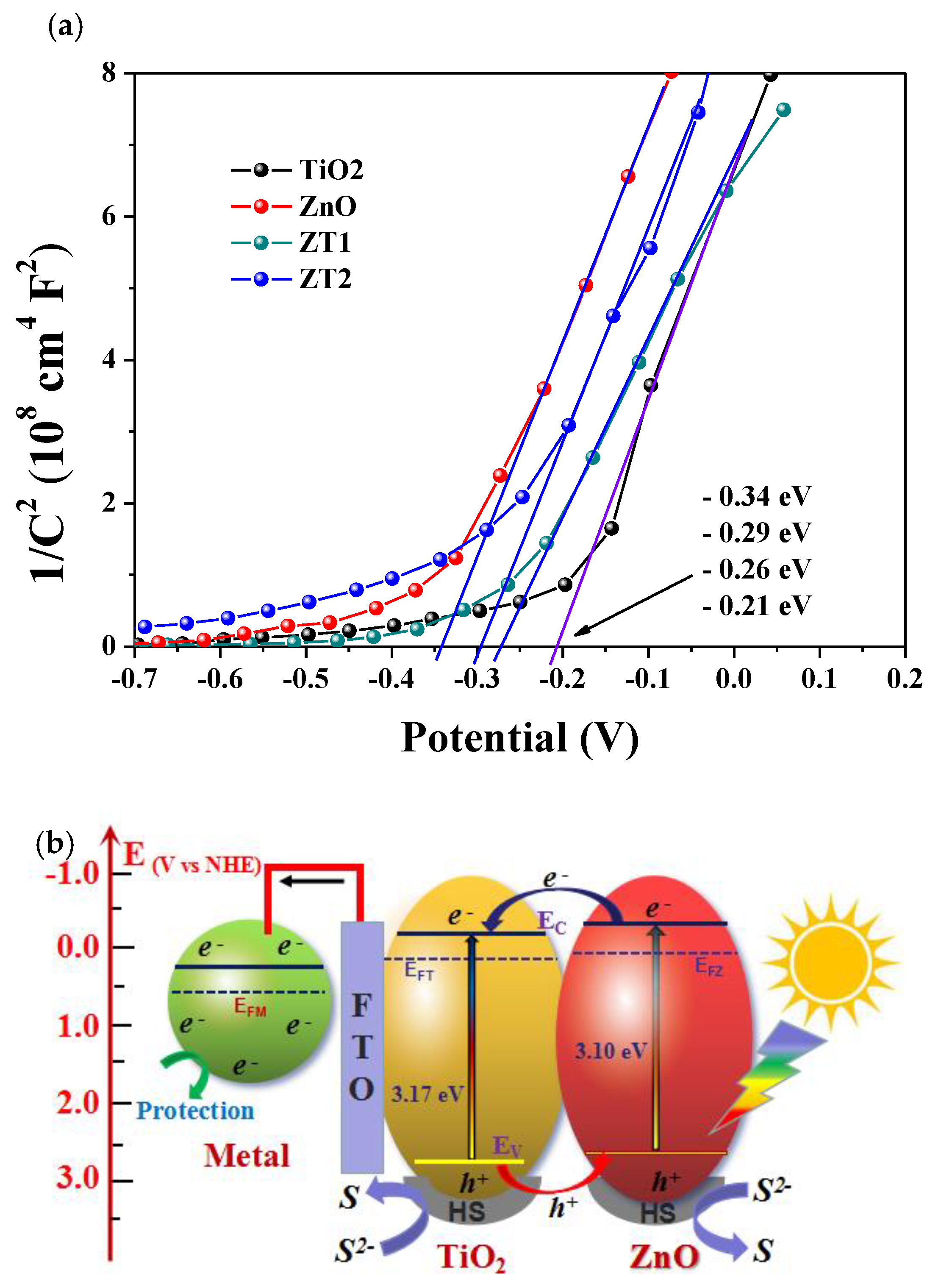
| Type | C | Mn | Si | S | P | Ni | Cr | Mo |
|---|---|---|---|---|---|---|---|---|
| 316SS | 0.08 | 1.80 | 0.90 | 0.029 | 0.045 | 14.00 | 17.00 | 2.00 |
| Q235 | 0.19 | 0.59 | 0.30 | 0.05 | 0.44 | - | - | - |
© 2019 by the authors. Licensee MDPI, Basel, Switzerland. This article is an open access article distributed under the terms and conditions of the Creative Commons Attribution (CC BY) license (http://creativecommons.org/licenses/by/4.0/).
Share and Cite
Zhang, X.; Chen, G.; Li, W.; Wu, D. Preparation and Photocathodic Protection Properties of ZnO/TiO2 Heterojunction Film Under Simulated Solar Light. Materials 2019, 12, 3856. https://doi.org/10.3390/ma12233856
Zhang X, Chen G, Li W, Wu D. Preparation and Photocathodic Protection Properties of ZnO/TiO2 Heterojunction Film Under Simulated Solar Light. Materials. 2019; 12(23):3856. https://doi.org/10.3390/ma12233856
Chicago/Turabian StyleZhang, Xiong, Guanghui Chen, Weihua Li, and Dianwu Wu. 2019. "Preparation and Photocathodic Protection Properties of ZnO/TiO2 Heterojunction Film Under Simulated Solar Light" Materials 12, no. 23: 3856. https://doi.org/10.3390/ma12233856






